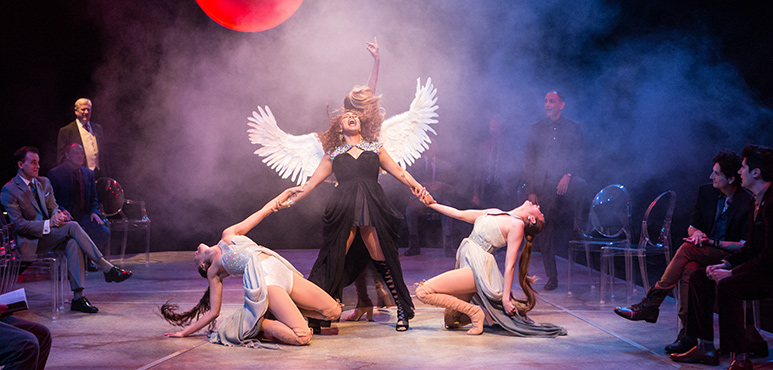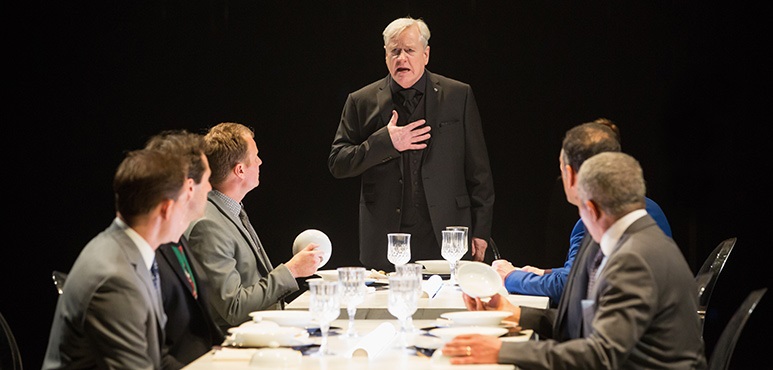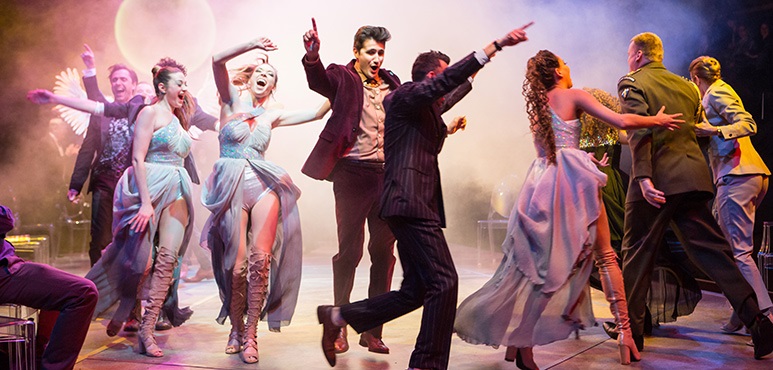Theater Reviews – In the Glassy Margents
A Taste of Timon: Stephen Ouimette’s Production at the Stratford Festival

In the 2017 production of Timon of Athens in Stratford, Ontario, the director Stephen Ouimette returns to some of the staging choices he has made in the same venue in 2004 (with Peter Donaldson playing the lead). As in the earlier production, the world of the play has been modernized: high-powered characters wear suits, the philosopher Apemantus is casually attired in jeans and looks like someone we might encounter on a university campus, and the military figures, most significantly Alcibiades, appear in fatigues. In both productions, Timon pours gasoline on his treacherous friends and threatens to set them on fire (although exchanges his earlier candelabrum for a lighter); throws a medlar back and forth during the conversation with Apemantus in the wilderness to lend a playful air to their encounter but also to emphasize the philosopher’s “meddling” in the affairs he does not fully understand; and suffers a slow death of starvation, with vivid hallucinatory dreams, throughout the second half of the play. The sound of machine gunfire and military aircraft introduces Alcibiades’ invasion of Athens, and at the end of the play, bodies of dead and wounded citizens litter the stage, with one figure feebly crawling forward on the ground. [1] In this revision of his earlier production, Ouimette makes an argument for Timon who moves from boundless generosity and perfect trust in others’ essential goodness, to deadly, near-apocalyptic despair at their betrayal.
The visual presentation of Timon’s sojourn in the wilderness explicitly references King Lear’s exposure to the elements on his heath: Timon retires to a bare and barren expanse of land, with no place to conceal himself save the grave-like hole he has opened up in the stony ground. An innovative design feature – a gigantic opaque half-sphere mounted into the theater wall, glowing pitiless yellow to indicate daytime, and becoming an eerie opal to signal the nightfall – further emphasizes his physical vulnerability to the forces of nature. Timon’s curses are treated as an echo of Lear’s realization that his society is unjust, dishonest, and cruel. At the same time, the production skirts the problems of interpretation that this link between the two characters produces.

Perhaps one of the crucial differences between Lear and Timon lies in their capacity for critical self-reflection. Lear’s epiphany contains a painful awareness that he governed and perpetuated this society, participating – sometimes indirectly, and sometimes in a very immediate fashion – in its injustices and cruelties. What does it mean that Timon castigates the world that has betrayed him, that he gleefully funds its destruction yet refuses to examine either his own former entanglement in this world or the position of others without wealth and power? Rather than address this problem head-on, Ouimette’s production chooses to mitigate it. It downplays Flavius’ attempts to warn his master, and Poet’s description of his own cautionary poem in the opening scene. It also considerably cleans up Timon’s later rants against the Athenian society – for instance, removing the episode where Timon pays Alcibiades’ prostitutes and urges them to infect all of Athens with venereal disease.
In a heart-felt and moving performance by Joseph Ziegler, Timon is presented as a well-meaning and fully sympathetic character. In the first half of the play, he sits at the long banquet table with his devoted companions, many of whom will soon betray him, and feeds them, as we will soon realize, the very last of what makes him Timon, the respected public figure. The Last Supper implications of this scene reverberate through the second half of the play, when one of the three Strangers, having witnessed Timon’s servant begging Lucius for money, remarks: “I never tasted Timon in my life” (3.2.77). Apemantus, it must be noted, does not taste of Timon’s feast either, instead bringing along his own snack of carrots in a baggie, which he takes out while declaring his preference for eating “root” (1.2.79).
In Ouimette’s production, Timon’s belated realization of his companions’ tenuous allegiances destroys not simply his desire to live in Athens, but his ability to continue living in this treacherous and dishonest world. Despite digging for roots and referring to springs of water somewhere in the vicinity, he is visibly failing with each appearance. Timon’s gradual running-down is emphasized by Ziegler’s supremely moving gesture as he is chasing off unwelcome visitors on two occasions. Approaching the edge of the stage, he raises both arms above his head in an expression of towering rage… and stops, like a windup toy whose spring has failed. Alone on the stage by this time, Timon (unlike King Lear) realizes that his rage is entirely futile: it has no clear target, and carries no potential for change. After a long moment of silently holding his position, with a puzzled expression on his face, Timon slowly lowers his arms to the sides. We cannot fail to empathize with Timon’s sense of loss and displacement here, or in a later episode, when he picks up a large black umbrella, left behind by the fleeing Poet and Painter, opens it, and stands silently under the umbrella, peering into the distance. (On the night when I attended the performance, weather played along: heavy rain started right on cue, audible through the thin roof of the Tom Patterson theatre and bringing to mind the Fool’s closing song in Twelfth Night.) While Timon’s generosity and investment in mutual care culminate in soul-destroying disappointment, there still seems to be a possibility for grace in the end of the play: in the closing scene, Flavius arrives to deliver his master’s epitaph (this production only retains the second epitaph), and, as the stage goes dark, a spot of light remains trained on the upturned face of the faithful steward.

Still, this moment is at odds with the fact that Timon extends forgiveness to no one, and feels no need to make amends or seek anybody’s forgiveness. His encounter with Flavuis at the end of Act 4 teasingly introduces the possibility of reconciliation, and then harshly snuffs it out: Timon gives gold to Flavius (who had earlier reimbursed the household servants out of pocket) not to reward his honesty but to breed in him a similar hatred against the entire humanity. There are few clues in the modernized production to guide the audience through these contradictions. The characters’ generic suits and an array of expensive electronic devices (laptops, smartphones, even a virtual reality headset worn by Lucius in Act 3, Scene 2) align them with the world of business and politics but offer no explanation for Timon’s own position at the beginning of the play. If he is also a successful businessman or a politician, what accounts for his blithe lack of awareness and business sense? If he has inherited his extravagant fortune and is now spending it to purchase flattery and admiration, brushing off the worried steward, to what extent can we really sympathize with his plight?
Similarly unresolved is the issue of women. Timon of Athens famously includes only two named female characters – the prostitutes accompanying Alcibiades during his visit to Timon in the wilderness – and a group of ladies dressed as Amazons, who come in to dance during the banquet. This production erases the prostitutes, along with the references to venereal disease. While Alcibiades is flanked by two female actors in fatigues, they are not necessarily read as female characters, since by this time the production has already cast women as gender-neutral messengers. Instead, Alcibiades’ moral standing is buttressed by an addition of a demure wife in the banquet scene. On the other hand, Timon’s fair-weather friends Lucullus and Lucius are each supplied with carnivalesque women whose virtue seems very much in question. Lucullus’ Servant transforms into a glamorous woman dressed only in a bikini, sunglasses, and high heels, tanning herself in a deck chair and resentful of the request to bring wine. Lucius’ three Strangers are women in blonde bobbed wigs, lounging around while he is lost in a virtual reality world. In the banquet scene, the corrupt nature of Timon’s companions is clarified to the audience by having them dance with a group of female entertainers in high heels and flimsy white dresses, led by a statuesque dark-skinned woman in a black dress, a set of white wings, and tremendous false eyelashes (Timon and Apemantus observe the dance from the sidelines). There is no question that the director is highly aware of the play’s gender disbalance and its characters’ contemptuous view of women, and attempts to address the problem by removing the explicit references to prostitutes, and inserting more women into the production. But ultimately, and troublingly, these largely silent, lavishly accessorized women serve as props, testifying, in very conventional ways, to the male characters’ integrity or lack thereof.

Still, leaving the Tom Patterson Theatre, I felt that this production has fulfilled its most important function, by leading me to consider, perhaps for the first time, what Timon of Athens might mean for the contemporary audience. By modernizing the characters’ clothes and bringing markers of technological progress onto the stage, this production strips the play of its usual status as a timeless fable about philanthropy and misanthropy. We then have to ask: where is the place, in the twenty-first century, for a middle-aged man in possession of an extravagant fortune which he refuses to manage? How does he find himself in this high-powered, cut-throat, thoroughly masculine world without having acquired at least some wariness and business sense? And how might a modernized production replicate, or translate, the palpable threat presented to this world by femininity– the threat implied in the play by the Amazon outfits of the ladies and the uncontrollable, disease-spreading bodies of the two prostitutes?
Stephen Ouimette’s production of Timon of Athens in Stratford makes a strong case for reviving this play, which has been, in the recent years, infrequently staged and, possibly, even less frequently taught. With all of its exasperating ambiguities and omissions, its seemingly simplistic didacticism and questionable attitudes toward women, Timon of Athens actively invites focused directorial intervention and offers a fascinating challenge to the twenty-first-century audience.
[1] The details of the 2004 production are described in Anthony Dawson and Gretchen Minton’s introduction to the Arden edition of Timon of Athens (2008, pp. 141-145). As they point out, the 2004 staging of the final battle drew on the 1991 production, also in Stratford, Ontario, which introduced the sound of helicopters (144).
